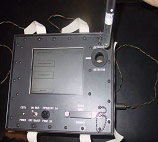Measuring radiation in space with bubble detectors
Purpose
A bubble detector is a radiation sensor that can be used to measure neutron levels. Neutrons make up 30% of the radiation that astronauts are exposed to in space. These neutrons are formed when protons interact with the shielding of a space vehicle. The Canadian Space Agency's Operational Space Medicine (OSM) Group is supporting the development of a personal detector system for space use based on the Canadian bubble dosimeter technology to improve monitoring of individual astronauts' neutron exposure during space missions.

Two bubble detectors. The detector on the right has been exposed to neutrons. (Credit: Bubble Technology Industries Inc.)
Background
A bubble detector is the size and shape of a test tube or a human finger. It contains a substance that is full of microscopic liquid droplets. When neutrons hit the droplets, visible bubbles of trapped gas form immediately. These bubbles can be counted visually or with a reader, and the number of bubbles indicates the level of the surrounding neutron radiation. The gas bubbles can be recompressed for reuse.
The Canadian company Bubble Technology Industries Inc. (BTI) originally developed the bubble detector for radiation detection in the nuclear industry. In 1988 the Canadian Space Agency (CSA) commissioned BTI to create bubble detectors for neutron detection in space, and in 1989 they were used for the first time in space to measure radiation aboard the Russian Bion-9 satellite. Since then, they have flown aboard other space vehicles, including the Russian Space Station Mir and the American space shuttle.

An illustration showing how a bubble detector works. (Credit: Bubble Technology Industry Inc.)
Project description
The CSA's OSM Group is working with BTI to develop a complete neutron detector system that can be used in space as a personal dosimeter by astronauts, or as an area monitor. The system includes bubble detectors and a data-reading device called a Mini-Reader. The Mini-Reader is being developed in collaboration with the State Scientific Center of the Russian Federation Institute of Biomedical Problems (IBMP) of the Russian Academy of Sciences and Rocket Space Corporation Energia (RSC-Energia). This system will be used for the first time in space in an experiment called Matroshka-R scheduled for 2005-2008 on the Russian segment of the International Space Station (ISS).
Matroshka-R will estimate the amount of radiation received by internal human organs in space by using a "phantom" – a spherical imitation of a human body made of material that is equivalent to human tissue. Bubble detectors will be inserted inside the phantom at various points. The detectors will be taken out of the phantom by cosmonauts at fixed intervals and the radiation exposure of the detectors will be read using the mini-reader. The mini-reader will provide a measure of the radiation dose for a given time interval and the total mission dose to date.
This system will give the astronauts an accurate reading of neutron exposures while they are in space. All radiation data can be stored electronically and instantaneously transmitted to Earth for further analysis.

Bubble detector (top right) being inserted into the mini-reader for a radiation reading. (Credit: BTI)
Related links
Explore further
- Date modified: